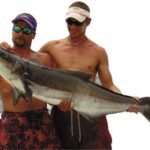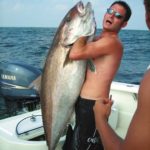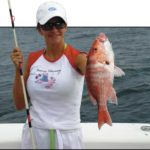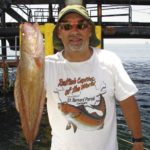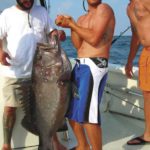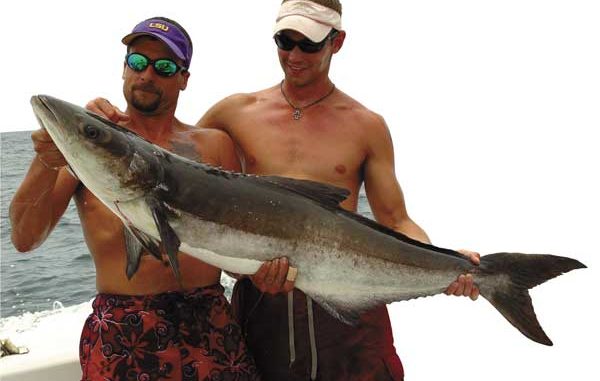
Learn to catch other species to make the most of this summer’s red snapper excursions.
Reports are that red snapper are teeming at virtually any rig off of the Louisiana coast. That would normally be good news except that snapper fishermen are facing a delayed, shortened season, combined with limits cut in half and fuel prices at the dock of more than $4 per gallon.
For some, that would be enough to not even leave the dock. However, with a little planning, a change of strategy and a little extra gear, limits of snapper can easily be augmented with lots of other tasty and fun-to-catch species.
For many red snapper fishermen, a trip used to mean specifically targeting only these bright-red, super-delicious fish. Any other fish caught while snapper fishing was simply viewed as a welcomed bonus. But now, the lean snapper limits mean these other species must also be targeted to maximize opportunities.
The 2008 red snapper season was delayed over a month and didn’t open until June 1. Additionally, the limit was lowered from four to two fish over 16 inches. When fishing for all reef fish, anglers are now required to use non-stainless steel circle hooks, and must have an approved hook remover and venting tool to aid in the healthy release of the fish.
The new regulations also eliminated the ability of the captain and crew of a licensed charter boat to keep their red snapper limits.
Capt. Damon McKnight of Super Strike charters in Venice has adapted his trips to maximize the types of fish targeted on what would normally have been a red snapper fishing trip.
“With the rising cost of fuel and the two-snapper-per-person limit, we necessarily have to try and keep the fuel costs down and still produce some quality fishing,” he said.
Putting together a good game plan offers some diversity to the typical snapper trip and gives anglers a chance to catch a variety of other fish.
Though it may sound elementary, McKnight says that the first cost-saving, odds- increasing technique is to plan to go to an area that you are sure will be holding snapper and live bait. Gone are the days of endless running from rig to rig hoping to finally find a bite. McKnight suggests that anglers get current reports from other fishermen and on-line forums in order to eliminate wasting time and fuel going to non-productive areas.
By heading to an area that has both snapper and live bait, McKnight combines his efforts so that he can target multiple species.
“When you’re at a rig that has snapper and live bait, you can fill your snapper limit and then load the boat with hardtails,” he said.
The hardtails make great amberjack baits, and can be caught using Sabiki rigs.
“For AJs, I like using 8- to 10-inch hardtails,” he said. “This seems to keep the smaller, undersized AJs off the hook, and attracts the bigger ones.”
In addition to snapper and amberjack, the savvy fisherman will also learn to target grouper and cobia. McKnight has special techniques for each species that constantly put his clients in the position to harvest multiple types of fish.
For snapper and grouper, the first thing McKnight recommends is looking at the fish finder.
“If it shows a pile of fish, I will tie up to the rig, down-current side, and see what’s biting,” he said. “This usually works very well, and will offer a wide variety of fish.”
However, there are some days when the majority of fish will be holding on the upcurrent side. When these conditions are present, McKnight will hold the boat near the center of the rig and let the anglers drop their baits.
“The upcurrent side usually holds more and bigger fish, but also requires a lot more boat maneuvering,” he said.
McKnight’s go-to equipment for snapper and grouper is Shimano Tekota reels mounted on Shimano Trevala rods.
“These are made for jigging, but can easily handle 15- to 20-plus-pound snapper and grouper,” he said.
McKnight spools up with 80-pound Power Pro braid with 80-pound mono leader and a circle hook.
If fishing over a wreck or other bottom structure, he recommends a marker buoy that can be deployed over the site.
“The buoy will let you mark where the wreck is in order to keep the boat in proper position to stay on the fish,” he said. “Wrecks will generally hold larger fish than rigs.”
In addition to red snapper, a variety of other keeper fish can be found at the same location. Vermillion, lane and mangrove snappers and several grouper species are just a few that can be added to the box in addition to the red-snapper limit.
Amberjack are extremely hard fighters and are another welcomed addition to the fish box. Although the limit is only one per person, the 28-inch minimum fork length ensures a mess of delicious filets to add to the pile.
Getting these swimming freight trains out from the rigs takes more powerful tackle and a specialized technique.
“This is a fun one,” McKnight said. “I use a Shimano TLD 50 with 200-pound mono and a 400-pound mono leader.”
McKnight’s favorite stick for battling amberjack is a Penn Mariner solid fiberglass rod with a custom bent butt. While this heavy equipment may seem like overkill, McKnight assures that it is necessary to successfully win the AJ battle.
“The heavy tackle will let you get them out of the structure without breaking off about 80 percent of the time,” he said.
He’s also particular about his bait.
“A live hardtail sent down on a 13/0 Mustad circle hook is guaranteed to meet a deadly fate,” said McKnight.
The war begins by positioning the boat at the center on the upcurrent side of the rig.
“I like to drop down about 100 feet, but if the AJs are thick, you won’t make it past 30,” he said.
Anglers should try various depths to see where the fish are holding.
“Having a Marks-o-lot ready to mark your line at the depth the fish are holding will help take the guesswork out of subsequent drops,” said McKnight.
Try various depths, and if nothing happens by the time you get to 200 feet, McKnight suggests moving to another location.
Now for the fun. McKnight says that on most days, you’ll barely have time to get the reel in gear before getting slammed by a big amberjack. Once the fish is hooked, the rod will double over so much it looks as if it’ll break. With a very tight drag set, the boat is immediately powered away from the rig with the rods still in the holder. This drags the fish out from the rig legs and allows the angler to fight it in open water with much less chance of being broken off.
“Once the fish is landed, I motor back to the rig and repeat with a drop back to the same depth.” said McKnight. “We’ll continue until we get our limit.”
Cobia are often inadvertently caught by snapper fishermen. However, learning to target them will increase the odds of adding a limit of lemons to the mix.
“Cobia will eat just about anything if they are fired up,” McKnight said. “Some days, all they have to do is see it, and they’ll eat it.”
McKnight’s favorite place to target cobia is on shallow grass lines. This requires sight fishing and a good pair of polarized glasses to help see the fish as they cruise along the line.
“Some days you can hook the entire school if you have enough rods ready, and others you may only find one or two every mile or so,” he said.
McKnight’s second technique for cobia is to use live or dead bait in areas that cobia are known to be.
“Some days they are just sitting on the bottom, and will eat anything that comes their way. On others, it almost seems as if they are just showing up as you are fishing,” he said.
Cobia are very exciting to catch and delicious on the table. McKnight recommends a Shimano Calcutta reel with 50-pound mono and a light rod.
“I prefer mono over braid because of their tendency to jump and their very fast runs next to the boat,” he said.
Cobia are tricky fighters, and oftentimes come to the boat when they are much too green for a successful landing.
“A lot of cobia are lost due to angler error, so you need to know a few tricks to keep them on the line and get them in the boat,” McKnight said.
He likes the stretch available with the mono since it gives more shock absorption and keeps from pulling the hook.
Getting a cobia to the boat and getting one in the boat can be two totally different matters.
“Some people aren’t very good with a gaff, and anyone who has ever gaffed a cobia knows they like to flip and twist coming off at the gaff, breaking the line and swimming away,” said McKnight. “If gaffing isn’t one of your strong points, an oversized scoop net is usually the best way to go.”
However, with cobia the battle isn’t over just because you get them in the boat. Many a cockpit has been ravaged by a wild lemonfish thrashing and slinging tackle and gear everywhere. Years ago, I caught a 60-pound cobia while trout fishing in Breton Sound. The fish easily came to the boat — too easily, as we soon learned.
Immediately upon hitting the floor, the fish turned into the Terminator. A buddy ended up riding the cobia like a bucking bronco in order to keep it in the boat. The brawl ended with one broken rod and a bloody angler, but we managed to keep the fish aboard.
McKnight warns about these situations.
“Some days they come in green, and you have to be cautious with them,” he said.
Be ready for last-minute action if you get a cobia into the boat.
“Try and go straight for the fish box if possible, and be ready to move out of the way. If not, you and your crew will be dancing all around the boat giving the rig workers a good laugh,” he said.
What may start off as a red snapper trip can easily be turned into an adventure that will have anglers battling a wide variety of species. In addition to the ones listed above, good action can also be found with a variety of sharks, triggerfish, mackerel, barracuda and others.
The limits and legal sizes vary widely for this smorgasbord, and anglers are encouraged to keep a copy of current regulations on board so informed decisions can be made as to whether a particular fish can be kept. Also, a good fish-identification book will help anglers know what they have caught and whether it’s good to eat.
Learning to diversify their offshore pursuits will help anglers offset the high costs of fuel and ensure a more productive trip.
Capt. Damon McKnight can be reached at (985) 960-1900, (800) 318-1720 or at www.superstrikecharters.com.
